ASO best practices: Advanced tips to grow your app in app stores in 2024
App store optimization has two goals: first, to show the app store algorithms that an app's product page is the one users want to find, and second, to convince users that an app's product page is the best answer to their needs. In consequence, ASO specialists perform optimization on two levels:
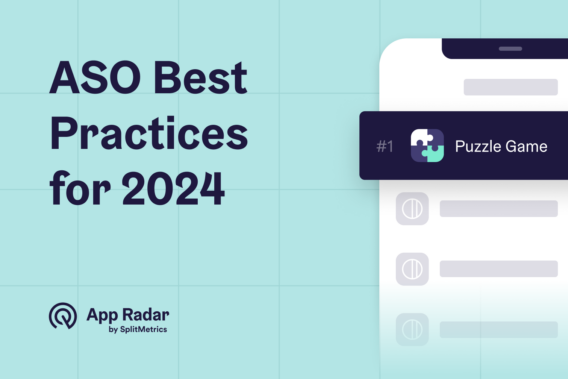
- Technical, geared towards robots and algorithms, it is concerned with making an app store work for us and not against us. It boosts the app’s visibility in the app store.
- User-centric and focused on making the app’s product page as appealing as possible. This level boosts the app’s product page conversion rate, driving more downloads.
The scope is big, and we need to connect the needs of algorithms with those of real people. This will be easy if we remember these best practices.
Connect what you show to the real needs of your users
Your primary focus of app store optimization should be on functionality. What your app does and how it benefits your users should be immediately obvious. Take a look at the example below:
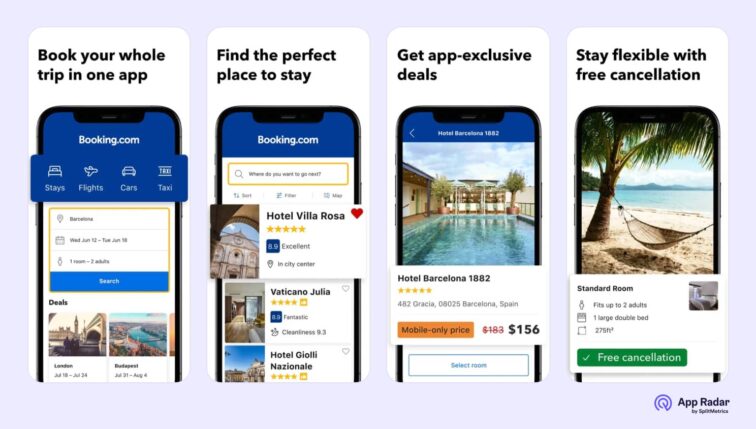
It’s safe to assume that you know what your app does and what problems it solves, but you might be surprised how difficult it can be to connect a developer’s perspective with the language product page visitors are compelled by.
All your design decisions regarding the app icon, screenshots, and other elements present on a product page will be based on showcasing functionality in a way that will incentivize users to download your app.
Desktop research allows us to make educated guesses, but only real-life data gives us certainty. For ASO, A/B testing is a key component of the visual part of it. For example, pre-launch A/B testing can point us in the right creative direction and save time optimizing something doomed to fail. There’s no limit to how early you can start, and there are tools to gather real data on what users want before a single line of code is written.
Tip: SplitMetrics Optimize, allows A/B testing of apps even before they’re released.
A/B testing is always actual and requires localization or seasonal changes. Even effective imagery will have a smaller impact over time as trends and preferences change.
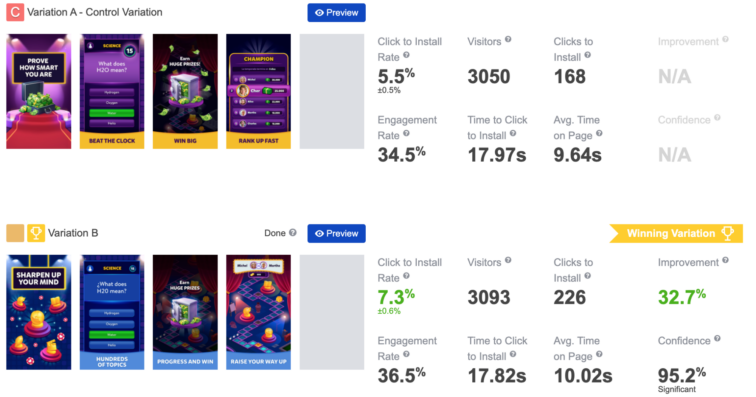
Consider gathering real-life data an obligatory step next to ASO competitive analysis, one that should influence your keyword expansion and design of product page imagery.
After your app or mobile game goes live, don’t stop gathering as much real-life data as possible within each store’s privacy policy scope. Ensure you have proper app analytics implemented to track in-app events and have a plan for each stage of the funnel when your actual data doesn’t hit those benchmarks you’ve set yourself.
To learn more about mobile game optimization, make sure to read our app store optimization guide for mobile games.
Prioritize your app's visibility
Impressions come before downloads; there’s no way around it – even if a user hits that “GET” button directly from search results.

App visibility on an app store refers to how easy your app is to find on an app store. Many factors influence it, including keyword optimization, product page metadata, and user engagement.
Higher visibility increases the likelihood of users discovering and downloading the app. Algorithms influence visibility and drive traffic and should be a priority for you. However, your app must be relevant to the search queries that lead to its product page. When it’s not the case, low conversion rates will turn against you and your visibility will drop.
To learn more about how to track your app’s visibility, we highly recommend checking our ASO KPIs and metrics article.
Optimize for search and exploration
Being visible on an app store goes beyond appearing in the search results. Both the App Store and Google Play allow users to discover apps organically in two ways: by performing a search or by exploring their contents. A good ASO strategy will influence visibility in both of them.

Algorithms analyze app product pages to make the best possible recommendations for users. Solid ASO competitive analysis and keyword research will help you appear in that “You might also like” section or “Recommended for you.”
Make ASO work for other user acquisition channels
ASO focuses on optimizing an app’s visibility and appeal within a given marketplace. However, in practice, its influence impacts other user acquisition channels. For example:
- For paid advertising, aligning ad creatives and copy with optimized keywords from ASO improves relevance and click-through rates. Positive app store experiences from ASO positively impact the conversion rates of paid ads. This alignment is especially true for Apple Search Ads and Google App Install Campaigns.
- In the case of social media, ASO’s emphasis on visual assets (app icons, screenshots) benefits social media promotion by providing compelling visuals.
- Influencers showcasing the visually optimized elements from ASO can enhance app appeal. Positive app store reviews contribute to a better user experience by influencers.
- ASO-driven visuals and key selling points can be integrated into email campaigns for consistent branding. Reviews and ratings influenced by ASO can be utilized for positive testimonials in email content.
In many cases, you will probably use custom product pages or custom store listings for external user acquisition channels, but only sometimes. ASO provides a strong foundation for overall app marketing strategies, ensuring consistent messaging, positive user experiences, and optimal visual appeal across diverse acquisition channels.
Use ASO checklist and follow a systematic approach
Using an ASO checklist can significantly help you during your daily work – it will help you to not forget about important ASO aspects that matter for app visibility in app store.
An app store optimization checklists typically give you an actions plan, such as:
- Optimize the app title, subtitle, and keywords for relevance.
- Write a compelling app description with key features.
- Use high-quality icons, screenshots, and preview videos.
- Focus on positive reviews and ratings.
- Update the app regularly for performance and user feedback.
- Analyze and refine using ASO tools and analytics.
So make sure to be well prepared for ASO challenges in advance.
Be relevant for search algorithms and users
Your and app store search algorithms’ mutually shared goal is delivering the best possible content to users. Search algorithms use a combination of technical information from your app’s product page and user feedback as signals to determine your ranking, although the exact mechanisms aren’t open. There are notable differences between the App Store and Google Play, two main marketplaces out there, but the main lesson is to always adhere to this rule: you need to be relevant on a technical and human level at the same time.
This relevancy means always considering parameters for visibility and relevance and maximizing impressions only for those with a certain relevance threshold.

User signals influencing ranking are app downloads, ratings and reviews, keyword conversion rate, app performance, and keyword retention rate. Never forget about the human element in optimizing your content, or you’ll see drops in visibility and traffic.
Remember keyword ranking eligibility for the App Store & Google Play works differently
The App Store and Google Play utilize advanced algorithms to deliver the best possible search results to their users. Guarded as closely as the legendary Coca-Cola recipe, KFC spices & herbs, or the WD-40 formula, we’re left with best practices recommended by app stores to stay visible and discoverable.
Remember, technical ASO for them is different in some areas and because visibility is our priority, let’s list all relevant factors here. First, those working for both of the main app stores are:
- App name
- Developer name
- Downloads
- Conversion rate
- In-app purchases
- In-app events
- User ratings
A high conversion rate is evidence of a good match between a search query and the result. Logically, in-app purchases & events are strong signals of user engagement, which is solid evidence of the app being a good match for a search query. Similarly, high ratings boost conversions and serve as a good indicator of the quality of an app for the algorithm, impacting organic ranking twofold. Ranking factors unique to the App Store are:
- App subtitle
- App’s URL
- Keywords in the keyword field
- Primary and secondary category name
Now, let’s look at how Google Play works. In search for keywords, it scans the following:
- Short description
- Long description
- Package name
- User reviews
Always stay up to date with technical aspects of app store optimization. Follow our blog and we also highly recommend reading this article:
App store ranking factors: App Store vs. Google Play. Read the article to grasp all ranking factors summarized in this accessible and informative article.
Create a strategy that will check all these boxes
Search drives the majority of downloads on both Google Play and the App Store. When it comes to keywords, focus on visibility but stay relevant. Sounds easy and is so in practice if you don’t miss a step in creating a robust keyword strategy. A strategic approach to keywords involves a simple yet impactful process:
- Keyword research and expansion: start by building an expansive keyword list using any tools. This research should encompass competitor analysis, industry trends, and user behavior insights to uncover high-performing keywords with significant search volume and low competition. If you are not sure which tools to use, make sure to check our list of top and best ASO tools.
- Keyword analysis & prioritization: once identified, prioritize keywords based on their relevance to the app’s content and their potential reach in attracting users. This prioritization ensures a focus on keywords that offer the greatest opportunity for driving traffic and conversions.
- Implement the selected keywords within the app’s metadata, including the app title, subtitle, keyword field, and description. Careful placement of keywords in these areas optimizes the app’s visibility in search results and increases the likelihood of appearing in relevant user searches.
- Measure performance and organic uplift: as the app gains traction, regularly measure keyword performance and assess its impact on organic uplift, app rankings, and user acquisition. Analyzing key metrics such as keyword rankings, search impressions, and app store visits provides valuable insights into the effectiveness of the keyword strategy and informs iterative improvements.
This process boosts your app’s visibility and positions it favorably in the competitive app landscape.
Get indexed for the right keywords and understand their value
Keywords are your top priority when it comes to ASO. Each type offers its opportunities and is tied to unique challenges.
- Branded keywords include the name of your app or your name as a developer and are a crucial traffic source. They are very efficient in terms of driving downloads relative to their share in your overall keyword pool. Their effectiveness may be boosted by any activities that drive the visibility of your app, like through alternative placements on app stores.
- Generic keywords are broad and commonly used terms that describe the functionality of apps, their subcategories, their style, or the problems they solve. They’re key to the exploration and discovery of new apps. Their strength lies in their volume.
Most searches are simple, and less than half are longer than 3 words. The most popular search queries are one-word names of brands. This trend is also similar for
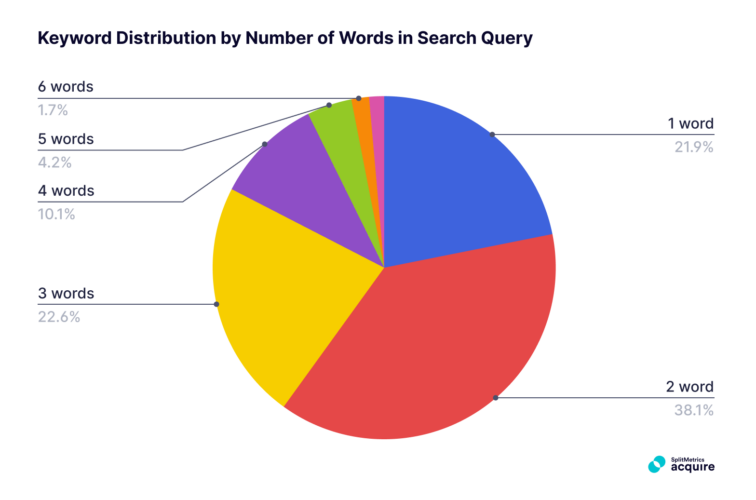
Don’t discredit the importance of long-tail keywords, especially for Google Play, where skillful writing of your app’s textual description can influence their organic visibility. Their sheer volume will help you gain more traffic incrementally.
Don’t hesitate to rank high for branded keywords and those for which you run ads. Having the very top position in paid and organic search results is beneficial. Look at the example below:

Be meticulous in optimizing your conversion rate
Conversion rate optimization is the second pillar of ASO. It’s a collection of tactics for converting the incoming traffic into downloads and revenue. There’s no way around it – a whole load of elements contribute to what makes a good conversion rate and it’s necessary to keep an eye on all of them:
- Compelling app icon: design an eye-catching and recognizable app icon that conveys the essence of your app to increase click-through rates.
- Optimized app title: craft a concise and keyword-rich app title that communicates the app’s value proposition and relevance.
- Persuasive app screenshots: use high-quality screenshots showcasing key features and benefits, encouraging users to explore further and include CTAs for conversions.
- Appealing feature graphics: design visually appealing feature graphics that complement your app’s message and enhance overall aesthetics.
- Informative app previews: create engaging (and short) video previews to provide a dynamic preview of your app’s functionality. Don’t waste a single second!
- Clear app description: write a concise yet informative description highlighting key features and addressing user needs and concerns.
- Localized content: tailor app store content to local languages and cultural nuances to resonate better with the target audience.
- Manage ratings and reviews: encourage positive reviews and respond to user feedback promptly, fostering a positive reputation.
- Targeting the right keywords: Only select relevant keywords that will be visible to users who are interested in your app.
Conversion rate optimization is the aspect of ASO that deals with the human reception of your app’s product page. Because of this, the scope of what impacts the conversion rate is wide, and real-life effects can differ from our expectations.
Run A/B tests and experiments
Every app needs A/B tests to reach its full potential. The scope of these tests can vary greatly depending on the stage of app development or marketing.
- Pre-launch A/B tests can deal with bold changes to the entire app or product page design concept by choosing which specific features to highlight.
- Post-launch A/B tests focus on incrementally improving the effectiveness of various product page elements, although bold changes can also be made at this stage.
A/B testing is crucial in embracing festive periods like Christmas, Halloween, and so on, as they need to be incorporated into the design to make an effect. They are fundamental to international scaling and creating more culturally relevant imagery.

Use seasonal tactics to target one-time events
Speaking of embracing seasonality and festive periods, they are a fantastic opportunity to build a connection with an audience on any app store.
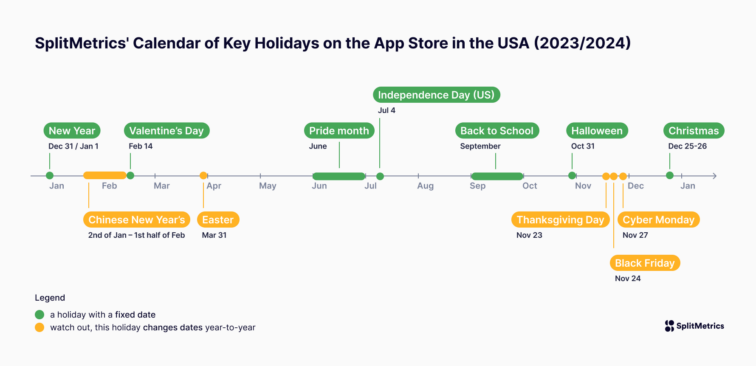
Tip: Check out SplitMetrics’ Ultimate Seasonality Guide for User Acquisition on the App Store for insights into design practices. For tips on optimizing keywords and other intel on seasonality, read App Radar’s guide to Leveraging Seasonality for More App Downloads.
Traffic grows during holidays, as many customers know that many apps will offer unique updates and they have more free time to seek entertainment. Many apps (but not all of them) can take advantage of this with in-app events and special offers.
Festive periods offer great opportunities during a relatively short period, but ASO specialists can embrace them in multiple ways. The popularity and relevance of certain keywords fluctuate, and app stores showcase new & updated apps in various lists. Your main focus will be updating imagery on your app’s product page, but consider new keywords, too.
Localize your app for different markets
Localizing your product page to scale on foreign markets is a crucial aspect of ASO. Regional preferences & customs have a very noticeable impact on conversion rates. Those preferences make localization a more complex activity that should go beyond merely translating the app’s descriptions.
The scope of this task varies depending on the app. Not all steps are necessary. To make international scaling less scary and viable even for a small developer or publisher, embrace the concept of minimum viable localization (MVL).

Minimum Viable Localization (MVL) for an app refers to the essential steps to make the app accessible and user-friendly for a specific target audience or market with minimal effort and resources. The goal is establishing a functional and culturally relevant presence in a new region without exhaustive localization efforts. Key components of MVL include:
- Language support: translate essential elements like app descriptions, menus, and basic instructions into the local language.
- Localized metadata: adapt metadata such as the app title and description to suit the language and preferences of the target audience.
- Cultural sensitivity: make basic cultural adjustments to ensure the app content aligns with local norms and preferences.
- Regional app store optimization (ASO) involves tailoring keywords, descriptions, and visuals to cater to users’ search behavior and preferences in a specific region.
By implementing these fundamental steps, developers can gauge the viability of their app in a new market before committing extensive resources to full-scale localization.
Tip: We highly recommend reading this guide: What is App Localization?
Manage your reviews and ratings
Managing user reviews and ratings is a dynamic process that significantly influences your app’s reputation and long-term success. While you may not have direct control over user opinions, fostering open, swift, and friendly communication can positively impact their sentiment over time. After all, 90 % of users consider star ratings to be an essential part of app evaluation based on our very own data. User review management involves these three elements:
- Communication with users leaving reviews: timely and constructive responses to reviews show dedication to user satisfaction, fostering positive relationships and a user-centric app image.
- Encouraging new users to rate and review: ask satisfied users for feedback to boost positive sentiments, enhance app ratings, and provide valuable insights for improvement.
- Analysis and measuring of impact: monitor and analyze feedback, identifying trends and areas for improvement.
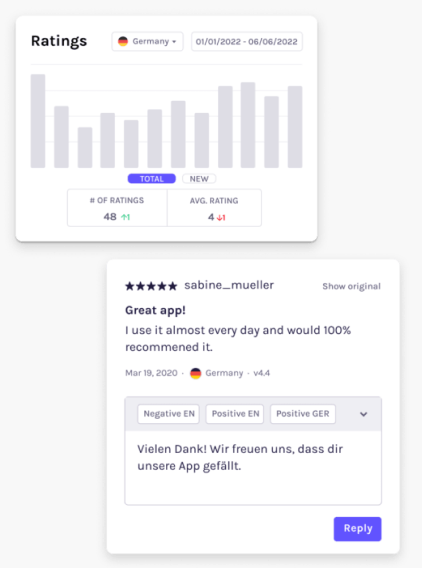
Take advantage of each store’s promotion opportunities and tools
Successful app store optimization means embracing every opportunity that suits our app and its business model. Fortunately, boosting user engagement and providing new opportunities for app developers to reach out to audiences with quality apps lies in the best interest of app stores, which systematically evolve to create the best user experience possible. Check out the tools and services listed below:
- App Store pre-order: users can preview and pre-order your app before the release date, driving anticipation and boosting initial downloads upon launch.
- Google Play pre-registration campaigns: encourage users to sign up for notification upon app release, building excitement and gauging interest before launch.
Tip: Running pre-launch campaigns can create a download base that will stimulate better organic rankings.
- Google Play Instant: allows users to try select parts of your app without installing it, offering a preview to boost engagement and conversion.
- Apple App Clips: quick, lightweight parts of your app that users can access without full installation, offering instant value and engagement.
- Custom store listings in Google Play: tailor your app’s presentation for different audiences or regions on the Google Play Store, optimizing visibility and appeal.
- Custom product pages on the App Store: personalize your app’s presentation on the App Store to highlight key features, improving conversion and user understanding.
Tip: Custom product pages can have a higher conversion rate than a regular one. Thanks to them, this feature can improve your organic rankings as your overall conversion rate grows.
- In-App events on the App Store: showcase limited-time events or promotions within your app on the App Store, attracting new users and retaining current ones.
- Google Play promotional content: feature your app with banners, discounts, or other promotions on Google Play to enhance visibility and downloads.
- Google Play Points: reward users for making purchases on Google Play, fostering loyalty and encouraging continued engagement.
- Google Play Pass: subscribers gain access to a library of premium apps and games on Google Play, providing additional monetization opportunities for developers.
- Apple Arcade: it’s a subscription service offering access to a curated collection of premium games on the App Store, providing a unique gaming experience.
Tip: Being a part of these subscription services or reward systems will increase your app’s visibility, as it will take advantage of each app store’s promotional efforts.
Work on your app being featured
App featuring refers to the promotion or highlighting of an app by the app store itself. It typically involves showcasing in curated lists, banners, or special sections within the app store, which can significantly increase an app’s visibility and downloads. Being featured by the app store can provide valuable exposure and credibility to an app, driving higher user engagement and downloads.
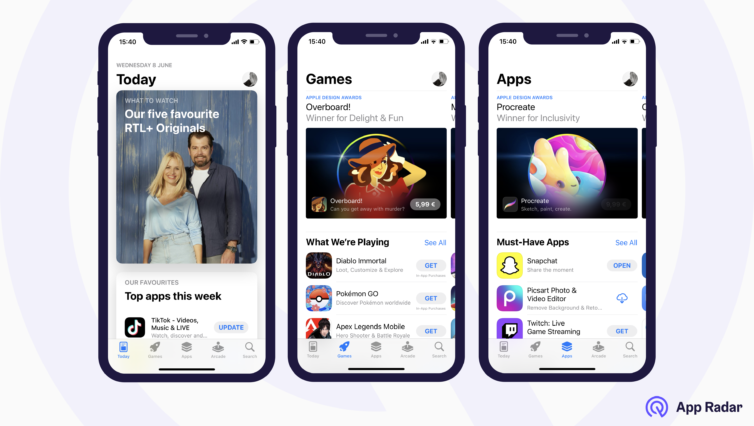
A good ASO strategy and following the best practices in this article will increase your chances of getting featured. In a nutshell:
- Build a high-quality app: ensure your app is well-designed, functional, and offers a positive user experience.
- Update regularly: regularly update your app with new features, bug fixes, and improvements to demonstrate ongoing commitment to quality.
Tip: How do you get your app featured? Find out in this article that talks about how to get featured in the App Store.
A meticulous approach to ASO will help you appear in automated sections (like top charts) by having the right app category, metadata, Google tags, etc. Don’t forget that some content is curated manually. By doing the same things important to users – localization, holiday campaigns, in-app events, and so on – you simultaneously work towards being noticed by editors of these app stores.
Always capitalize on ASO with paid user acquisition
ASO is the foundation of all app marketing strategies, but it won’t create the app independently. With over 3,5 million apps on Google Play and close to 1.8 million on the App Store, it won’t be enough to make an impact.
Paid user acquisition will help you create a synergistic effect, as high conversion rates and downloads are a strong signal for organic visibility. You need a paid user acquisition source, and if you want to take advantage of that synergy with ASO, you need one bringing high-quality traffic. There are many ways to acquire users, but consider the three below as absolutely fundamental:
- Apple Search Ads: Apple Search Ads is an ad management platform for the App Store, a source of high-quality traffic, with official average conversion rates around 60% (for ads appearing in the search results. According to data published live on the SplitMetrics’ Apple Search Ads Benchmark Dashboard – even higher numbers being possible), with three additional placements on the main page, product pages and the Search tab to connect with users on various stages of their journey.
- Google App Install Campaigns: The App Install Campaign is one of the three possible campaign types you can run with Google Ads. It’s a straightforward service that focuses on increasing your app installs. Your ads will appear on the Google Play store, YouTube, Google Search Network, and Google Display Network.
- Social Media campaigns are a key component of paid user acquisition for any app due to their precise targeting, reach, and visual appeal.
Tip: Read more about Google App Install Campaigns on our blog: How to launch Google App Install Campaigns?
Use the right set of tools to monitor KPIs and app progress
Good ASO strategy requires extensive keyword research, competitive analysis, observation of trends, shifts in rankings, traffic, and evaluation of product page performance – plenty of insights to keep up in the fast-paced environment of the App Store and Google Play. It’s good to have access to tools that boost productivity or add more layers of functionality beyond what’s offered by both app stores to understand better what ASO tactics to implement.
- App Radar – ASO, organic keyword intelligence, and market research
- SplitMetrics Acquire – Apple Search Ads management, automation & optimization platform
- SplitMetrics Optimize – A/B testing, pre-launch and post-launch
Final thoughts
Navigating the competitive landscape of app stores requires savvy ASO strategies. Despite the complexity, success is attainable through meticulous keyword research, compelling visuals, and user-centric optimization. With dedication and best practices, apps can rise above the competition and thrive in today’s dynamic digital marketplace.
Keyword Intelligence, Market Intelligence, Competitor Insights.
We have all the data to help you pick the right organic ranking strategy.
Latest Posts
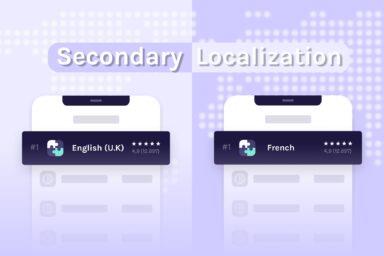
iOS App Product Page Localization: How to Use it the Right Way to Improve ASO
Top 10 Most Downloaded Games in Google Play Store (July 2025 Update)
Google Play Store Listing Experiments: How to Run Native A/B testing for Android Apps for Free!
12 Best Mobile Measurement Partners (MMPs) to Consider for Your Mobile App Attribution in 2025
Academy Lessons
Continue lessons



